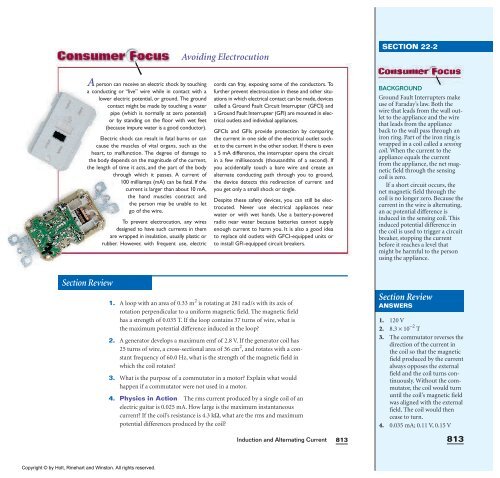Induction and Alternating Current with teacher's notes
Induction and Alternating Current with teacher's notes
Induction and Alternating Current with teacher's notes
Create successful ePaper yourself
Turn your PDF publications into a flip-book with our unique Google optimized e-Paper software.
A person can receive an electric shock by touching<br />
a conducting or “live” wire while in contact <strong>with</strong> a<br />
lower electric potential, or ground. The ground<br />
contact might be made by touching a water<br />
pipe (which is normally at zero potential)<br />
or by st<strong>and</strong>ing on the floor <strong>with</strong> wet feet<br />
(because impure water is a good conductor).<br />
Electric shock can result in fatal burns or can<br />
cause the muscles of vital organs, such as the<br />
heart, to malfunction. The degree of damage to<br />
the body depends on the magnitude of the current,<br />
the length of time it acts, <strong>and</strong> the part of the body<br />
through which it passes. A current of<br />
100 milliamps (mA) can be fatal. If the<br />
current is larger than about 10 mA,<br />
the h<strong>and</strong> muscles contract <strong>and</strong><br />
the person may be unable to let<br />
go of the wire.<br />
Section Review<br />
To prevent electrocution, any wires<br />
designed to have such currents in them<br />
are wrapped in insulation, usually plastic or<br />
rubber. However, <strong>with</strong> frequent use, electric<br />
Copyright © by Holt, Rinehart <strong>and</strong> Winston. All rights reserved.<br />
Avoiding Electrocution<br />
cords can fray, exposing some of the conductors. To<br />
further prevent electrocution in these <strong>and</strong> other situations<br />
in which electrical contact can be made, devices<br />
called a Ground Fault Circuit Interrupter (GFCI) <strong>and</strong><br />
a Ground Fault Interrupter (GFI) are mounted in electrical<br />
outlets <strong>and</strong> individual appliances.<br />
GFCIs <strong>and</strong> GFIs provide protection by comparing<br />
the current in one side of the electrical outlet socket<br />
to the current in the other socket. If there is even<br />
a 5 mA difference, the interrupter opens the circuit<br />
in a few milliseconds (thous<strong>and</strong>ths of a second). If<br />
you accidentally touch a bare wire <strong>and</strong> create an<br />
alternate conducting path through you to ground,<br />
the device detects this redirection of current <strong>and</strong><br />
you get only a small shock or tingle.<br />
Despite these safety devices, you can still be electrocuted.<br />
Never use electrical appliances near<br />
water or <strong>with</strong> wet h<strong>and</strong>s. Use a battery-powered<br />
radio near water because batteries cannot supply<br />
enough current to harm you. It is also a good idea<br />
to replace old outlets <strong>with</strong> GFCI-equipped units or<br />
to install GFI-equipped circuit breakers.<br />
1. A loop <strong>with</strong> an area of 0.33 m 2 is rotating at 281 rad/s <strong>with</strong> its axis of<br />
rotation perpendicular to a uniform magnetic field. The magnetic field<br />
has a strength of 0.035 T. If the loop contains 37 turns of wire, what is<br />
the maximum potential difference induced in the loop?<br />
2. A generator develops a maximum emf of 2.8 V. If the generator coil has<br />
25 turns of wire, a cross-sectional area of 36 cm 2 , <strong>and</strong> rotates <strong>with</strong> a constant<br />
frequency of 60.0 Hz, what is the strength of the magnetic field in<br />
which the coil rotates?<br />
3. What is the purpose of a commutator in a motor? Explain what would<br />
happen if a commutator were not used in a motor.<br />
4. Physics in Action The rms current produced by a single coil of an<br />
electric guitar is 0.025 mA. How large is the maximum instantaneous<br />
current? If the coil’s resistance is 4.3 kΩ, what are the rms <strong>and</strong> maximum<br />
potential differences produced by the coil?<br />
<strong>Induction</strong> <strong>and</strong> <strong>Alternating</strong> <strong>Current</strong><br />
813<br />
SECTION 22-2<br />
BACKGROUND<br />
Ground Fault Interrupters make<br />
use of Faraday’s law. Both the<br />
wire that leads from the wall outlet<br />
to the appliance <strong>and</strong> the wire<br />
that leads from the appliance<br />
back to the wall pass through an<br />
iron ring. Part of the iron ring is<br />
wrapped in a coil called a sensing<br />
coil. When the current to the<br />
appliance equals the current<br />
from the appliance, the net magnetic<br />
field through the sensing<br />
coil is zero.<br />
If a short circuit occurs, the<br />
net magnetic field through the<br />
coil is no longer zero. Because the<br />
current in the wire is alternating,<br />
an ac potential difference is<br />
induced in the sensing coil. This<br />
induced potential difference in<br />
the coil is used to trigger a circuit<br />
breaker, stopping the current<br />
before it reaches a level that<br />
might be harmful to the person<br />
using the appliance.<br />
Section Review<br />
ANSWERS<br />
1. 120 V<br />
2. 8.3 × 10 −2 T<br />
3. The commutator reverses the<br />
direction of the current in<br />
the coil so that the magnetic<br />
field produced by the current<br />
always opposes the external<br />
field <strong>and</strong> the coil turns continuously.<br />
Without the commutator,<br />
the coil would turn<br />
until the coil’s magnetic field<br />
was aligned <strong>with</strong> the external<br />
field. The coil would then<br />
cease to turn.<br />
4. 0.035 mA; 0.11 V, 0.15 V<br />
813
















